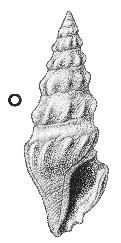
Revised descriptions of New Zealand Cenozoic Mollusca from Beu and Maxwell (1990)

 | Revised descriptions of New Zealand Cenozoic Mollusca from Beu and Maxwell (1990) | 
|
  (Pl. 22o): GS9520, J41/f8029, Awamoa Creek, Oamaru, Altonian (GNS) |
Beu & Maxwell (1990): Chapter 11; p. 211; pl. 22 o.
Synonymy: Austroclavus marshalli Powell 1942, p. 120
Classification: Drilliidae
Description: Rather small for subfamily (height 8-10.5 mm), narrowly fusiform, spire 0.6 total height. Protoconch narrowly conical, of about 5 whorls, smooth except for a narrow cord margining lower suture. Teleoconch of 5-6 whorls, bluntly shouldered somewhat above middle on spire, sutural ramp concave, sides convex; last whorl weakly excavated. Axial sculpture of prominent, rounded opisthocline costae reaching from shoulder angle to lower suture on spire, typically becoming shorter on last whorl, forming little more than peripheral tubercles in some shells; 9 or 10 on penultimate whorl. Last whorl with rounded varix some distance (up to quarter of a whorl) behind outer lip. Spiral sculpture restricted to 7 or 8 narrow cords on neck, rest of shell glossy. Aperture small, ovate; columella gently convex, siphonal canal short, shallowly notched. Inner lip with well developed parietal callus pad, narrowly callused below. Outer lip with deep, subtubular anal sinus, convex below except for shallow stromboid notch near anterior end.
Comparison: Austroclavus marshalli is easily distinguished from A. tenuispiralis (Pl. 26k) by its smaller size, its more rounded teleoconch whorls, by not having the axial costae sharply truncate at the shoulder, and by having spiral sculpture restricted to the neck. Austroclavus differs from Splendrillia largely by its tall, conical protoconch of 4-5 whorls, rather than a smaller, blunt, dome-shaped protoconch of 2 or fewer whorls in Splendrillia. Powell (1942) did not compare them, and their positions in his classiification indicate that he did not consider them to be closely related, but this appears to be another case of a solely developmental difference of little significance in phylogeny. The incidence of conic-protoconch species assigned to Austroclavus also decreases with time towards the present day, at the same time as the number of dome-shaped protoconch species assigned to Splendrillia inceases. It therefore seems likely that New Zealand (and Australian) drilliids lost planktrotrophy with time, and Austroclavus species evolved into Splendrillia species from many different ancestors, exactly as happened with Tomopleura and "Maoritomella" species. Austroclavus, therefore, is possibly not a useful genus, although this conclusion still requires further research before it is accepted.
Distribution: Otaian-Altonian; Mount Harris Formation, Pukeuri road cutting, Oamaru, Altonian (type); Awamoa Creek; Ardgowan Shellbed; Target Gully Shellbed; Bluecliffs, Otaio River; foot of Mt Horrible, Pareora River; uncommon at all localities.
Cite this publication as: "A.G. Beu and J.I. Raine (2009). Revised
descriptions of New Zealand Cenozoic Mollusca from Beu and Maxwell (1990). GNS
Science miscellaneous series no. 27."
© GNS Science, 2009
ISBN
978-0-478-19705-1
ISSN 1177-2441
(Included with a PDF facsimile file
copy of New Zealand Geological Survey Paleontological Bulletin 58 in CD version
from: Publications Officer, GNS Science, P.O. Box 30368 Lower Hutt, New
Zealand)